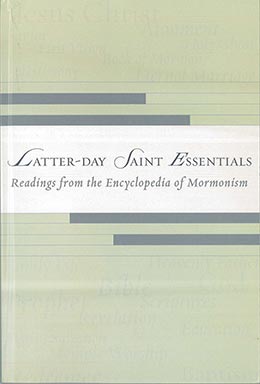Mormonism, Mormons
Donald K. Jarvis
Donald K. Jarvis, “Mormonism, Mormons,” in Latter-day Saint Essentials: Readings from the Encyclopedia of Mormonism, ed. John W. Welch and Devan Jensen (Provo, UT: BYU Studies and the Religious Studies Center, Brigham Young University, 2002), 6–8.
“Mormonism” is an unofficial but common term for The Church of Jesus Christ of Latter-day Saints and the doctrinal, institutional, cultural, and other elements forming its distinctive worldview and independent Christian tradition. “Mormons” is the equivalent term for members of the Church, with “Mormon” being both the singular noun and the adjective.
Over the years these terms and other, less common variants have been widely used (such as “Mormonite” in early decades of the Church), but members prefer the official name revealed by the Savior to the Prophet Joseph Smith—The Church of Jesus Christ of Latter-day Saints—in order to emphasize the central role of Jesus Christ in their doctrine and worship (D&C 115:3–4). The shortened name that most contemporary members use instead of “Mormonism” is “LDS Church,” with “LDS” used in place of “Mormon” and “Latter-day Saints” or “Saints” used instead of “Mormons.”
The term “Mormon” derives from the Book of Mormon, published in 1830 and recently subtitled Another Testament of Jesus Christ. This book is accepted by the Church as scripture along with the Bible.
Mormonism refers to the divinely inspired doctrine taught by Joseph Smith and the succeeding leaders of the Church. It views human life as a stage in the eternal progression of intelligent beings who, as God’s spirit children, must choose, in thought and deed, whether to accept or reject Christ’s gospel, teachings, and covenants. Latter-day Saints see the Church’s teachings as true Christianity, restored to earth in its original purity by Christ himself, and thus they frequently refer to the Church, its doctrines, and its priesthood as “restored.” Basic Church doctrines include belief in a personal God vitally concerned with his children, the divinity of the Savior Jesus Christ and his infinite Atonement, the universal need for repentance and baptism by proper authority, continuing revelation through living prophets, the brotherhood and sisterhood of all human beings, the eternal sanctity of marriage and family, and the responsibility to be self-reliant and to help others. Many of the basic beliefs of the LDS Church are succinctly summarized in the thirteen Articles of Faith, which serve, among other things, as an outline of the basic doctrines for members of the Church.
A salient characteristic of Church practice is the delegation of specific ecclesiastical responsibilities to every active member of the Church. This results in a high level of voluntary member activity, commitment, and sense of community. Only men belong to the priesthood; but both women and men share priesthood blessings, and both hold significant leadership and teaching positions, perform missionary and temple work, and participate prominently in most Church meetings. Other notable Church practices include the encouragement of education, thrift, community service, missionary work, genealogical record keeping, and temple worship.
While the Church is clearly conservative on many issues, its central reliance on continuing revelation provides a divinely guided flexibility, especially in areas of practice. Through the living prophet, changes are effected as revelation is sought and received. Two main practices discontinued over the years are polygamy, officially ended in 1890, and gathering to a central geographical location, largely ended in the 1920s (Allen and Leonard, p. 496–97). At the same time, other practices have been introduced: Tithing, revealed in the 1830s, has been normative since the 1890s; and the complete avoidance of drugs such as tobacco, alcohol, tea, and coffee has been formally required of all active members since the 1920s, nearly a century after first having been revealed. Family home evenings, introduced in 1915, were widely instituted as a weekly practice in the mid 1960s. Extension of priesthood authority to all worthy male members, regardless of race, was granted in 1978. Latter-day Saints expect that further changes will be made by revelation as the needs of the Church unfold.
Mormonism is not a political ideology. The Church’s policy regarding governments allows it to thrive in a wide variety of political contexts around the world. It supports separation of church and state, respect for duly established law and government, and members’ active participation in civic and charitable affairs (D&C 134). War is generally condemned, but military service is not forbidden. Well before the 1950s, the Church frequently took positions on political issues, especially some affecting Utah. Since that time, Church leaders have increasingly urged members to decide such questions for themselves and have implemented a policy of Church neutrality toward government, except in instances where political developments clearly impinge on important moral issues or severely restrict members’ freedom to practice their religion.
Bibliography
Allen, James B., and Glen M. Leonard. The Story of the Latter-day Saints. Salt Lake City, 1976.
Arrington, Leonard J., and Davis Bitton. The Mormon Experience. New York, 1979.
The Church of Jesus Christ of Latter-day Saints. Gospel Principles. Salt Lake City, 1981.
Richards, LeGrand. A Marvelous Work and a Wonder. Salt Lake City, 1988.
Talmage, James E. Articles of Faith. Salt Lake City, 1988.
